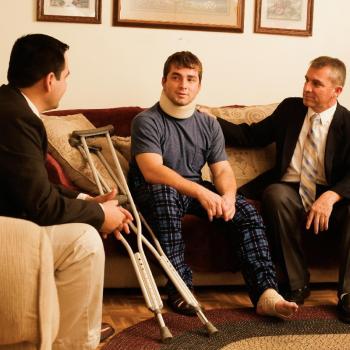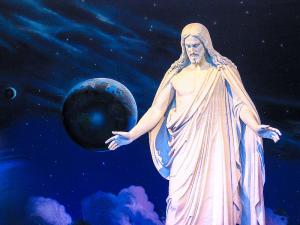Over the last week I’ve been re-reading Carol F. Karlsen’s book on witchcraft in Puritan New England and, strangely, this has reminded me how deeply religious traditions have shaped regional cultures and identities in the U.S. I grew up in Andover, Massachusetts, one of the centers of the witchcraft hysteria of 1692. We’d visit Salem and all the historical (and tacky) commemorations of that event. I assumed everyone knew a lot about the Puritans and witchcraft. And the Pilgrims and how they settled Plymouth. And also about the Shakers and their furniture. Or that the visit of the Pope was a major, show-stopping event that would be carried live on local television. It wasn’t until I moved out of New England that I saw how I carried with me a regional historical memory of New England’s religious past and how this memory shaped my sense of identity as a New Englander. The Quakers and William Penn loomed large in eastern Pennsylvania where I went to college, while Baptists churches dominated the built landscape and the political discourse during my year in Georgia. Irish (and, increasingly, Mexican) Catholicism served as a shaping force in Chicago public culture and identity, as Mormon history was a ubiquitous touchstone in Utah.
One could argue that these various regional religious traditions have directly shaped the political, economic, literary and artistic, social, and moral cultures of these respective regions—sometimes in ways hard to track. How, if at all, does the Puritan heritage contribute to the political blueness of Massachusetts, for instance? But it seems to me that it’s just as important to consider how residents of these regions use their historical memory of these religious traditions as points of identity and pride. In other words, these remembered traditions become part of the regional cultural religion of residents. Here I’m using Catherine Albanese’s concept of American cultural religion (a riff on the concept of American civil religion) and suggesting that different areas in the U.S. have their own regional versions of American cultural religion and that these regional cultural religious discourses are partly shaped by how we as residents remember the historical religions of our areas, whether those memories are accurate or not. After the bombing at the Boston Marathon, notice how the Puritan and Revolutionary War heritage was invoked to assure Bostonians and Americans that New Englanders were “Boston Strong” and would bounce back from tragedy with resolve and toughness. I lived in Salt Lake City in 1997, the 150th anniversary of the arrival of Mormon pioneers into the Salt Lake Valley. As part of this anniversary, a large group of modern-day Mormons re-enacted the trip by covered wagon, horse, and even on foot. There was daily coverage of this event on the local news. When the group arrived in Salt Lake on Pioneer Day (July 24th), the annual state holiday celebrating the arrival of the pioneers, the city turned out to meet and celebrate them. The adventurous spirit and courage of the pioneers became a place where modern Utahns, especially Mormons, could find a mirror for themselves and their region in the present. Like the shell-shocked Bostonians, in the public discourse surrounding the commemoration, Utahns were an exceptional people because of their exceptional religious heritage.
Moving to the Northwest, a region that, on the surface, is devoid of a shaping historical religious influence, I had to look beyond institutional religious expressions to try to understand how regional identity was developed in the public discourses of Oregon and Washington. Nowadays, Northwesterners tend to overlook the ruthless missionary and military energy directed in the nineteenth and twentieth centuries towards Native Americans. Instead, the dominant public discourse in the Northwest envisions the region’s environmentalism and engagement with nature as a direct descendant of these pre-European Native American cultures and religions. Moving to the Northwest also prompted me to see more clearly how mass media and commercial culture feeds and shapes this historical memory of religions. It seems to me that electronic communication and mass culture has not erased these regional differences, as for instance, Robert Bellah might argue. Rather, producers and consumers of mass culture have, not surprisingly, latched on to regional historical memory and exploited it for economic gain. An insurance company here in the Northwest runs print and television ads about how they are unusual, just like the unusual, nature-crazy residents of the Northwest whom the company presents in a portrait series of Northwest “types:” the Portlander who haunts the food carts, the Northwesterner who has a picnic on the beach no matter the weather, etc. (Notice how food is a major element in Northwest identity!) Here, as elsewhere–New England, Utah, Pennsylvania–the exceptionalism at the heart of American cultural religion is transformed into regional forms supported by memories of local religious traditions and by profit-seeking mass media outlets. While this is inevitable and perhaps largely harmless, I wonder if as residents of whatever regions we inhabit, we should also question our desire for this exceptionalism, especially as it resides in the authoritative example of remembered pious religious people of the past. Perhaps we should look past the easy commercialized whitewashing of these memories and to the traditions themselves, the good and the bad. Maybe we should observe and exploit the more critical elements of these traditions: the self-interrogation of the Puritans, the Quaker suspicion of hierarchy and authority, the way Mormons and Northwest Native Americans (each in very different ways) pushed against individualism and prized communal health and wealth. Maybe this would be a more fitting tribute to these traditions, a more accurate way that we are, in some way, their regional descendants.











